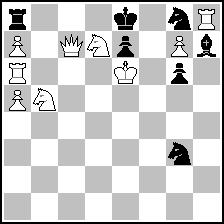|
| Page: [Previous] [Next] 1 2 3 |
| (1) Posted by Andrey Selivanov [Tuesday, Feb 23, 2016 07:17]; edited by Andrey Selivanov [16-03-02] |
FIDE Olympic Tournament in Composing 2016
studies:
http://www.wfcc.ch/wp-content/uploads/Baku-Chess-Olympic-ty-Provisional-study-award-2016.pdf
|
|
| (2) Posted by Andrey Selivanov [Wednesday, Mar 2, 2016 23:11] |
threemovers:
http://www.wfcc.ch/wp-content/uploads/Baku-Chess-Olympic-ty-2016-3.pdf
|
|
| (3) Posted by Andrey Selivanov [Sunday, Mar 6, 2016 14:33] |
Selfmates:
http://www.wfcc.ch/wp-content/uploads/Baku-Chess-Olympic-ty-2016-S.pdf
|
|
| (4) Posted by ioannis kalkavouras [Sunday, Mar 6, 2016 16:54] |
The 2nd Prize winner by A.Oganesyan, in logical style, is really fantastic. I believe that despite the minor dual on W3,it's destined for the anthologies.
Bravo Alexei!
|
|
| (5) Posted by Aleksey Oganesjan [Wednesday, Mar 9, 2016 05:46] |
Thank you, Ioannis!
|
|
| (6) Posted by Miodrag Mladenović [Wednesday, Mar 9, 2016 22:56] |
The minor dual could be avoided by extending stipulation to S#10
Version of 2nd Prize by Aleksey
 (= 9+7 ) (= 9+7 )
S#10
1.Qe5 0-0-0 2.Qc5+ Kb7 3.b8Q+ Rxa8 4.Qb6+ Kc8 5.Qc6+ Kd8 6.Qc7+ Ke8 7.Qe5 Ra6+ 8.Sb6 Rxb6+ 9.axb6 ~ 10.Rxg8+ Bxg8#
However now there is no switchback by wSd7. So personally I do like more version with minor dual on third move.
|
|
| (7) Posted by Aleksey Oganesjan [Thursday, Mar 10, 2016 05:51]; edited by Aleksey Oganesjan [16-03-10] |
Version is quite interesting, but, apart from absence of wSd7 switchback, I see another following shortcomings:
- compare to diagram position, after 7.Qe5! Black has a new defence (Rxa6+) which was not in the initial position - thereby it slightly reduces an impression of logic paradox;
- these slightly rough moves - 7...Rxa6+ 8.Sb6 Rxb6+ 9.axb6 - are excess because its are not associated with the plan (its only delay an ending);
- insufficient loading of wRa6;
- rundlauf Qc7-e5-c5-b6-c6-c7 is less nice than Qc7-e5-d5-c6-c7 (to my taste).
And, besides that, this version has... a short solution in 9 moves!
1.Qe5 0-0-0 2.a8R+! Kb7 3.Rb6+ Kxa8 4.Rb8+! Rxb8 5.Qd5+ Rb7 6.Sb6+ Kb8 7.Qe5+ Rc7 8.a6! - 9.Rxg8+ Bxg8#
In any case, I do like more my version too.
|
|
| (8) Posted by Sven Hendrik Lossin [Tuesday, Mar 29, 2016 13:36]; edited by Sven Hendrik Lossin [16-03-29] |
Congrats to Aleksei. A brilliant work. Promotion duals are no drawback.
Has somebody cooked the 7. in the s#-section? This can never ever work.
|
|
| (9) Posted by Torsten Linß [Wednesday, Mar 30, 2016 09:12] |
Both no. 7 (Stetsenko) and no. 34 (Ouellet) are unsound according to information from Olaf Jenkner (Gustav).
Nos. 17 and 18 are Co+
|
|
| (10) Posted by Sven Hendrik Lossin [Wednesday, Mar 30, 2016 10:00] |
I think I have said enough about ultralongmovers but they still get distinctions even though they are obviously not working. The lone voice in the wilderness...
http://matplus.net/start.php?px=1346533580&app=forum&act=posts&fid=tt&tid=993&pid=8810#n8810
http://matplus.net/start.php?px=1459324414&app=forum&act=posts&fid=gen&tid=1287
|
|
| (11) Posted by Frank Richter [Wednesday, Mar 30, 2016 10:49] |
It is a challenge, Sven-Hendrik, like the Babson, Oudot, AUW in a single-solution h#2, white AUW in a s# miniature etc.
So why not try to create the longest s# ever?
|
|
| (12) Posted by Sven Hendrik Lossin [Wednesday, Mar 30, 2016 13:40]; edited by Sven Hendrik Lossin [16-03-30] |
I would never criticize them for trying to create the longest s#.
If you take my words in the links seriously then you know that those selfmates can never be sound.
I expect from every author and especially the judges to perform this plausibility check before publishing/awarding.
|
|
| (13) Posted by Torsten Linß [Thursday, Mar 31, 2016 09:14] |
What should be criticized here is the lack of testing on behalf of the organizers. All it takes is an email to an experienced cook (their names are known) to have the most endangered entries checked. Fortunately, only lower ranked problems were affected this time.
|
|
| (14) Posted by Sven Hendrik Lossin [Friday, Apr 1, 2016 00:05] |
That is one point, TLi.
Id like to add two points:
1. The author should test intensively. Just an example: It took me a few days of testing to find in P1248493 that a white pawn on c6 is needed. This pawn disturbs the aesthetics but I thought it to be my duty to test.
2. I have given some criteria. Do we really need to cook that s# here when the chance of it being sound is even less than me beating Usain Bolt in 100 m running?
|
|
| (15) Posted by Olaf Jenkner [Wednesday, Apr 6, 2016 00:43] |
Yes, somebody has to cook the problem, otherwise it has to be considered as a new record.
On the other side: Somebody has to confirm that he saw you finishing the 100 meters before Mr. Bolt.
|
|
| (16) Posted by Andrey Selivanov [Tuesday, Apr 19, 2016 18:23] |
section helpmates; http://www.wfcc.ch/wp-content/uploads/Baku-Chess-Olympic-ty-2016-H-Award.pdf
|
|
| (17) Posted by Eugene Rosner [Tuesday, Apr 19, 2016 20:32] |
so back to the manymove selfmate...what is the currently longest S# that is considered sound and accurate?
|
|
| (18) Posted by Torsten Linß [Tuesday, Apr 19, 2016 22:48] |
The minimum for the record are 120 moves (P1182762 in the PDB)
|
|
| (19) Posted by Eugene Rosner [Wednesday, Apr 20, 2016 01:50] |
I guess then everything >120 has been cooked?!
|
|
| (20) Posted by Frank Richter [Wednesday, Apr 20, 2016 08:17] |
You may search in PDB for K='Shinkman-Blathy' to get some of the longest selfmates ever published.
The only (still) uncooked problem there is s#227 by Karlheinz Bachmann (P1176536).
|
|
Read more... |
Page: [Previous] [Next] 1 2 3
MatPlus.Net  Forum Forum  Competitions Competitions  FIDE Olympic Tournament in Composing 2016 FIDE Olympic Tournament in Composing 2016 |
 ISC 2024
ISC 2024 Forum
Forum  Competitions
Competitions  FIDE Olympic Tournament in Composing 2016
FIDE Olympic Tournament in Composing 2016 


